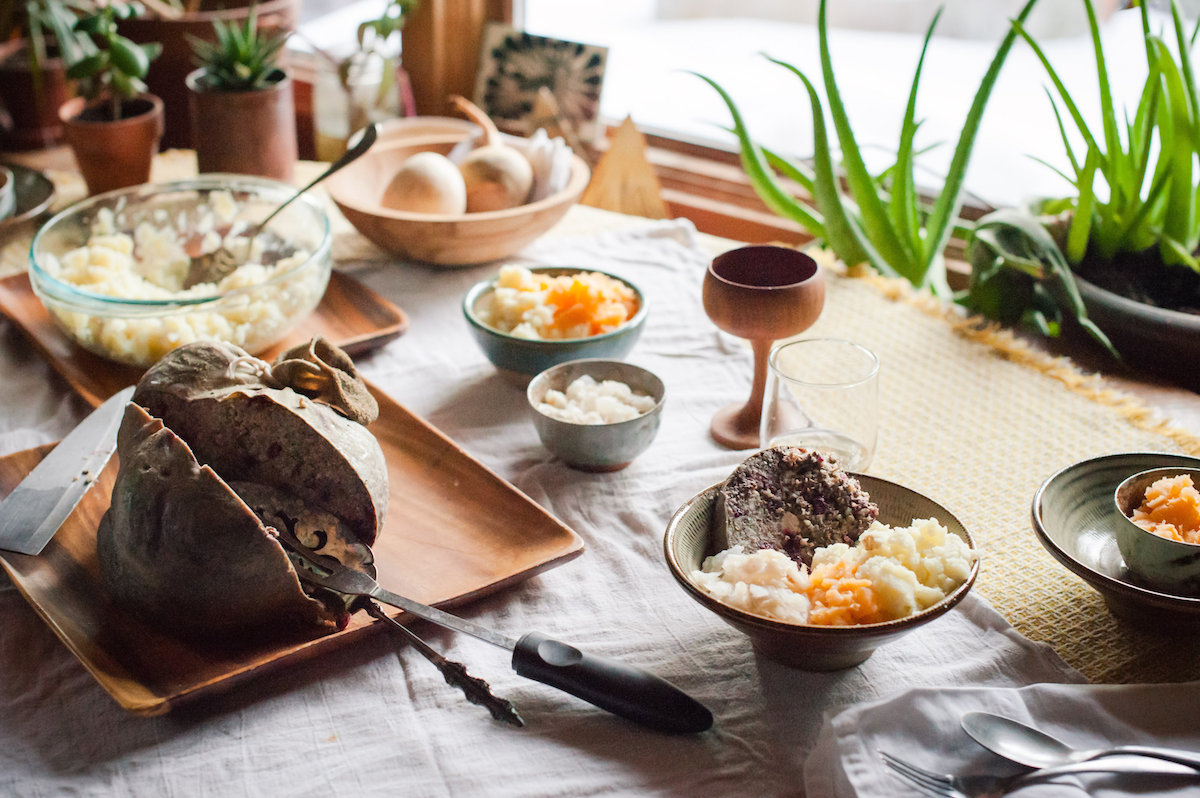Four Haggis, Two Chefs, and One Piper at a Robert Burns Night Supper
Candlelight flickered in the snow outside of the community hall in Ester, Alaska on a starry winter night. At -20º Fahrenheit, the cold chased the bundled-up guests indoors where they warmed up to the aromas of roasted vegetables and rich meats emanating from the kitchen. The potluck table quickly filled with dishes inspired from Interior Alaska’s bounty and culinary traditions from abroad. Guests of many nationalities mingled and nibbled on appetizers until everyone had arrived. When all were seated with orange foam earplugs in place, the chef and hostess retreated to the kitchen to heft a gray bundle from a stovetop pot onto a platter. The deafening drone of the bagpipes signaled the start of the evening meal. It was time to present the haggis to the honored guests.
With the rise of factory farming in the 20th century, along with changing food preferences, many “undesirable” parts of livestock were diverted away from the North American kitchen and relegated to low-quality food for pets and livestock. However, we can still look to cultures around the world today that have always valued everything an animal has to offer. Tripe, which includes stomach and intestines, is highly prized all over Europe, Latin America, Asia, and Africa. Older Iñupiaq friends still talk about hunters who “cook” organ meats with the vegetative contents of a caribou’s stomach, a mouthwatering meal called niġukkaun that is a rare delicacy today. Recently, the “nose-to-tail” movement has elevated the status of offal in contemporary Western cuisine with dishes like “pig ear soup” and “pig trotters” made popular by celebrity chef Fergus Henderson of St. John restaurant in London.
Because lamb is not part of my family’s Southeast Asian traditional food, I met with Ganim and Amber Ozcivi, a Turkish-American couple in North Pole who also purchased whole lambs from local farmers. Unlike myself, they knew exactly how to use everything, and they described how to recreate many foods from Ganim’s homeland, such as lamb head soup, roasted cubes of organ meats on a shish kebab, and bumbar dolması, a well-loved dish that combined rice, organ meats, and spices to cook inside lamb intestines.
From a home chef’s perspective, eating those odd bits, the unspeakable parts, the just-as-essential pieces of the animal, stems from a curiosity for knowing more about where food comes from, which means getting to know it from the beginning to the end, and from the inside out. Making an effort to use all pieces of the lamb instilled in me a deep appreciation for people all over the world who have perfected this art over the generations.
Scottish culture has long fascinated my friend “Kimbo” Maher such that she has always wanted to host a Robert Burns night supper to celebrate the beloved Scottish poet. Haggis is the culinary star of the supper, yet finding a sheep stomach in Fairbanks to make the haggis has always eluded her. Having purchased a whole lamb from friends at Frigid Farm in Two Rivers each year, I have always kept the organ meats with the goal of making haggis and other edible offal creations. However, these pieces accumulated untouched and underappreciated in my freezer over the years. Upon discovery of our common interest in an uncommon dish that utilized odd bits in my freezer, we planned a supper to include a classic Scottish haggis with oats and spices. Blessed with an abundance of lamb pieces, I also opted to create two new Alaskan haggis and another inspired by the stories and spices from my Turkish friends.
For all of the haggis, I prepared the stomach and organ meats the same way. I soaked the stomach in cold salted water with a splash of vinegar, and I boiled the lamb organs, also known in Britain as the “pluck,” with a single bay leaf. All of the organs were coarsely ground up with an onion and uncooked lamb suet.
For the classic Scottish haggis, I added pinhead oats and herbs to the organ mixture. For the Turkish-inspired haggis, I used rice, cumin, dried parsley, and a sweet pepper and tomato paste called salça, courtesy of the Ozcivis. For one Alaskan haggis, I chose barley from the windswept fields of Delta Junction. Foraged treasures from this past year offered dried Labrador tea leaves (Ledum groenlandicum) in place of bay leaf for boiling the organ meats. A cup of ruby-colored lingonberries (Vaccinium vitis-idaea) gathered last fall, and a handful of crumbled dried springtime spruce tips (Picea glauca, mariana, or Sitchensis) added a boreal bouquet to the mix. For the other Alaskan haggis, I used blueberries, and a variety of Alaskan-grown herbs.
After the grains and spices have been combined by hand with the ground-up organ mixture, the luscious mishmash is then stuffed into the paunch and tied neatly with a string. The savory pudding simmered in water for a few hours before serving.
I carried the steaming bundle on a platter, followed by the blaring bagpiper and Kimbo, the happy hostess. The procession circled the guests before setting the haggis on the table. Kimbo sliced open the haggis and poured Scotch whisky over it. One of the guests read Robert Burns’ “Address to a Haggis,” which begins with the lines, “Fair fa' your honest, sonsie face, Great chieftain o the puddin'-race!” Although nearly 4,000 miles away from Scotland, the celebration brought together Fairbanks friends who came to delight in many versions of an unusual-looking yet scrumptious dish. As with the greatest things in life, it’s not what’s on the outside that counts, but rather, the delightful combination of what is on the inside. We brought out the rest of the haggis and began the meal with a toast in honor of the poet, the piper, the guests, the farmers, the lamb, and all those who took part on this odyssey to continue old traditions and begin new ones.





